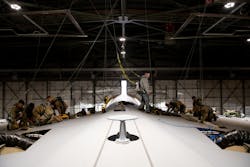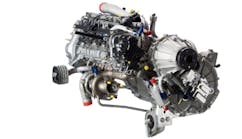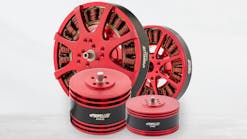3D Printed Parts for the C-5M Deliver New Capabilities
By Lan Kim, 60th Air Mobility Wing Public Affairs
TRAVIS AIR FORCE BASE, Calif. (AFNS) -- Maintainers from the 60th Maintenance Squadron and 349th Aircraft Maintenance Squadron, along with engineering and engineering support contractors from the C-5 System Program Office out of Robins AFB, Georgia, recently finished work to modify an internal part for a C-5M Super Galaxy by incorporating 3D-printed materials.
The printed blocks and wedges, supplied by the U.S. Air Force Rapid Sustainment Office, provide support to an aerodynamic fairing covering a wing splice on the C-5, said Clay Elliott, a C-5 structural engineering subject matter expert with the C-5 SPO. Fairings are structural elements that help reduce drag on an aircraft.
When a Travis C-5M landed in Charleston AFB, South Carolina, during a mission in December, the crew discovered during a post-flight inspection that a section of the hump-shaped aerodynamic fairing panel was missing.
“The technicians went up on the wing, and that's when they discovered that there was a massive delamination of the phenolic [blocks],” Elliott said.
The blocks, which normally provide internal support to the hump panel, were splitting apart, making the aircraft non-mission capable.
To get the aircraft fixed as soon as possible, Elliott proposed to integrate 3D-printed parts made from Antero 800NA, a new thermoplastic material, into the aircraft repair.
After a team of maintainers fixed the panel at Charleston, the aircraft was flown back to Travis for further maintenance. The process involved completely removing the legacy parts from the plane and re-bonding the new 3D printed blocks and wedges to the aircraft, then re-installing the panels.
“It’s pretty intense work with regard to getting all this stuff off, then getting it clean without causing damage,” Elliott said.
According to Elliot, the Antero material has shown promising results and the material appears to be impervious to natural elements.
“For what we're doing, 3D printed Antero seems to be a really solid replacement for phenolic,” Elliott said. “All the aircraft we've worked on so far with these improved materials and processes — we’ve haven't had any issues.”
Todd Hicks, 60th MXS Aircraft structural maintenance supervisor, highlighted how the new technology has expedited some C5-M maintenance and repairs. Integrating 3D printing technology resulted in faster turnaround times and reduced costs. It helps to provide the option for the 60 MXS to produce some parts on demand, rather than go through the lengthy process of sourcing parts from third parties if a part is unavailable locally.
Traditionally, spare parts for the C-5M have been expensive and time-consuming to produce, as they required specialized tooling and long lead times. However, the use of 3D printing has allowed for the creation of these parts in a more efficient manner, Hicks said.
“Hopefully, this is a one and done and it works great so we never have to revisit this again from the aircraft,” Hicks said.
Thousands of maintenance hours could be saved once the whole fleet of C-5s receives the new 3D blocks and wedges., said Hicks.
The integration of 3D printing technology into the maintenance and repair of the C-5M has had a significant impact for the U.S. Air Force. Faster repair times and the potential for cost savings have all combined to make the aircraft more operationally ready and cost-effective, Elliot said.





